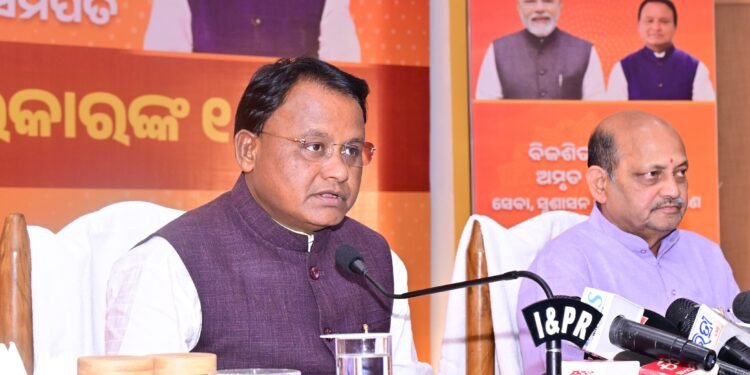Bhubaneswar- As the Bharatiya Janata Party (BJP) government in Odisha marks its first year in office, Chief Minister Mohan Charan Majhi presented a comprehensive performance report and laid out an ambitious developmental vision for the future at a press conference in Bhubaneswar on Tuesday.
Reflecting on the administration’s progress since taking charge, the Chief Minister noted that more than half—11 out of 21—of the BJP’s poll promises from its “Sankalp Patra” (election manifesto) have already been fulfilled within the first 12 months. “We haven’t merely governed—we have delivered on the expectations of the people,” Majhi asserted.
He credited Prime Minister Narendra Modi’s continued support and enthusiasm for Odisha’s progress, noting that the PM will visit the state again on June 20 to further bolster Centre-State collaboration.

Majhi highlighted the state cabinet’s prompt action after assuming office on June 12 last year, citing four major decisions that set the tone for people-centric governance:
Reopening all four gates of the Shree Jagannath Temple in Puri to devotees.Launching the Subhadra Yojana aimed at empowering women. Setting up a Rs 500 crore corpus fund for Jagannath Temple’s development. Granting a Rs 800 per quintal bonus to farmers on paddy procurement.
In a significant boost to Odisha’s agrarian economy, the Chief Minister announced a record Rs 37,800 crore allocation under the Samruddha Krushi Yojana, the largest agricultural budget in the state’s history. This is expected to benefit lakhs of farmers across Odisha.
He also pointed out the success of rural empowerment efforts, especially through women-led self-help groups. Over 17 lakh women, referred to as Lakhpati Didis, have been empowered, steering rural households towards self-sufficiency.
Majhi criticized the previous 5T school transformation initiative as superficial, saying it was mostly about painting school walls. In contrast, his government has prioritized core educational reforms. Every panchayat will now have a Godavarish Mishra Adarsh Vidyalaya, and the National Education Policy (NEP) is being implemented with focus on foundational learning through Shishu Vatika (early childhood education).

“Soon, parents will prefer government schools over private ones,” Majhi said confidently, pointing to improved infrastructure and academic standards.
Looking ahead, the Chief Minister outlined two flagship missions—Mission 2036 and Mission 2047—to guide the state’s long-term development strategy.
Mission 2036- This initiative is linked to the centenary celebration of Odisha’s formation. A total of 36 focused programmes will be launched across critical sectors such as healthcare, education, agriculture, infrastructure, environmental sustainability, and women’s empowerment. These will serve as benchmarks of Odisha’s growth trajectory leading up to the state’s 100th year in 2036.
Mission 2047- Coinciding with 100 years of India’s independence, this mission aims to make Odisha a key player in India’s growth narrative. It will emphasize innovation, green energy, digital governance, and economic leadership.

To ensure effective implementation, the state government has mandated inter-departmental coordination, goal-based planning, and citizen-first reforms. Each department will work with specific targets to make these visions a reality.
Chief Minister Majhi emphasized that both missions are not just ceremonial milestones, but transformational movements. “We are not just planning for today—we’re designing Odisha’s future with clarity, courage, and commitment,” he said.
As the BJP-led government steps into its second year, it does so with a promise of inclusive growth, transparent governance, and a bold vision to make Odisha a model state by 2036 and beyond.






